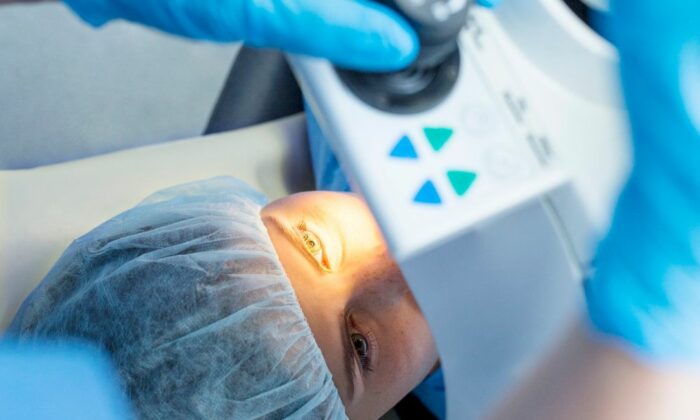Are you one step away from saying goodbye to your glasses forever, but find yourself standing at a crossroads, unsure of which path to take? You’re not alone! The journey to crystal clear vision often presents a vital question: to go for Flap LASIK or to opt for the Flapless route? That’s where we step in to guide you through this crucial journey. In this comprehensive guide, we will unveil the nuances of both Flap vs. Flapless LASIK eye surgery procedures, offering a bird’s-eye view and diving deep into the specifics of each.
So, sit back, relax, and let’s embark on this enlightening journey together. Your path to a glasses-free life is just a few scrolls away!
Contents
Understanding the Basics: Flap vs. Flapless LASIK
Embarking on a journey to a life without glasses is indeed exhilarating, but before you take the plunge, it’s essential to understand the two pathways that lie before you: Flap LASIK and Flapless LASIK. Let’s unravel the fundamental concepts of these two prominent surgeries to help you steer your journey in the right direction.
Flap LASIK: The Traditional Approach
 Flap LASIK, also known as traditional LASIK, is a procedure that has been a trusted choice for many over the years. In this process, a thin flap is created on the cornea, the clear front surface of the eye, using a microkeratome blade or a femtosecond laser. This flap is then lifted to expose the underlying corneal tissue. A laser is then used to reshape this tissue, which corrects the refractive error in the eye. The flap is then repositioned, adhering naturally without the need for stitches.
Flap LASIK, also known as traditional LASIK, is a procedure that has been a trusted choice for many over the years. In this process, a thin flap is created on the cornea, the clear front surface of the eye, using a microkeratome blade or a femtosecond laser. This flap is then lifted to expose the underlying corneal tissue. A laser is then used to reshape this tissue, which corrects the refractive error in the eye. The flap is then repositioned, adhering naturally without the need for stitches.
Flapless LASIK: The Modern Alternative
Stepping into the more recent advancements, we have the Flapless LASIK, also known as PRK (Photorefractive Keratectomy). In this approach, instead of creating a flap, the outermost layer of the cornea (epithelium) is gently removed to expose the underlying corneal tissue. The same laser used in traditional LASIK is then employed to reshape the cornea.
A Glance at the Primary Differences
At a glance, the primary difference between the two procedures(Flap vs. Flapless LASIK) lies in the initial steps – the creation of a flap in traditional LASIK and the removal of the epithelium in Flapless LASIK. This fundamental distinction leads to variations in recovery time, comfort levels, and suitability for different individuals.
As we venture further into this guide, we will delve deeper into the intricacies of each procedure, helping you weigh the pros and cons effectively.
The Flap LASIK Procedure: What to Expect?

Taking the step towards improved vision is both a momentous and meticulous journey. If you are leaning towards the Flap LASIK procedure, it’s pivotal to know what lies ahead. Let us walk you through the stages of this procedure, the technology harnessed, and the expected recovery timeline.
The Surgical Process
A comforting factor about the Flap LASIK procedure is that it’s quick, generally taking about 10 to 15 minutes for both eyes. Here’s a brief snapshot of what the process entails:
- Preparation: First, your eye surgeon will use numbing eye drops to ensure a painless experience. The surgeon will then clean your eyes and position them under the laser machine.
- Creating the Flap: Utilizing a highly precise instrument, either a microkeratome blade or a femtosecond laser, a thin flap is created on the surface of your cornea. This part of the procedure is vital, as it paves the way for the reshaping of the cornea.
- Reshaping the Cornea: Once the flap is lifted, an excimer laser is used to reshape the cornea based on the pre-determined calculations, correcting the refractive error in your eyes.
- Flap Repositioning: After reshaping, the surgeon will reposition the flap back onto the cornea, where it naturally adheres without the need for stitches.
Technology Behind the Scenes
The technology powering Flap LASIK is nothing short of revolutionary. The femtosecond laser used in creating the flap allows for high precision and control, making the procedure safer and the outcomes more predictable. The excimer laser, responsible for the reshaping of the cornea, is characterized by its ability to remove microscopic layers of tissue with utmost precision, thereby sculpting the cornea to achieve the desired refractive correction.
The Recovery Period
Post-procedure, you may experience a brief period of discomfort, including burning or itching sensations, which usually subside within a few hours. Remarkably, many individuals notice a significant improvement in their vision almost immediately, with further stabilization and clarity emerging over a few weeks.
Now that you have a clearer picture of what the Flap LASIK procedure entails, you might be pondering about its modern counterpart, the Flapless LASIK. Stay with us as we unfold the facets of this innovative approach in the next section.
The Flapless LASIK Procedure: An Overview

Stepping into the forefront of technological advancement, the Flapless LASIK, also known as PRK, presents itself as a viable and modern alternative for those seeking freedom from glasses. Just like its Flap counterpart, understanding the ins and outs of this procedure is key to making an informed decision. Let us guide you through the intricacies of this process.
The Surgical Process
Differing significantly from the traditional approach, the Flapless LASIK or PRK procedure adopts a different methodology. Here’s a glimpse into the step-by-step process:
- Preparation: Similar to the Flap LASIK, your eyes are first prepared using numbing eye drops to eliminate any discomfort, followed by cleaning and positioning under the laser equipment.
- Removing the Epithelium: In a departure from the Flap method, surgeons gently remove the cornea’s outer layer, known as the epithelium, exposing the underlying corneal tissue for reshaping.
- Corneal Reshaping: With the removal of the epithelium, surgeons use an excimer laser to carefully reshape the cornea, altering its curvature to correct the refractive errors in your eyes.
- Healing and Regrowth: After reshaping, surgeons place a protective contact lens over the eye to foster the epithelium’s natural regrowth, a process that spans a few days.
Technology at the Helm
In Flapless LASIK, the role of technology is critical in ensuring precision and fostering a smoother healing process. The use of advanced excimer lasers allows for a meticulous reshaping of the cornea, promising accurate results and a higher degree of safety.
The Recovery Phase
The recovery journey in Flapless LASIK is slightly different. While the procedure promises excellent outcomes, the recovery period might extend a bit longer compared to Flap LASIK. Initially, you might experience a bit of discomfort, or a gritty feeling in the eye, which diminishes as the epithelium regrows. Notably, full stabilization of vision might take a few weeks, as your eyes adapt to the new corneal shape.
Pros and Cons: Weighing Your Options
Choosing the right LASIK procedure (Flap vs. Flapless) is a significant decision that requires careful consideration of various factors. To help you weigh your options judiciously, we’ve listed down the pros and cons associated with both Flap and Flapless LASIK surgeries.
Flap LASIK
 Pros
Pros
- Quick Recovery: Often, patients notice an improvement in vision almost immediately post-surgery, with full recovery in a few days.
- Less Discomfort: Due to the quicker healing of the flap, patients experience less post-operative discomfort.
- Wide Range of Correction: Capable of correcting a wide range of refractive errors, helping many to achieve 20/20 vision or even better.
Cons
- Flap Complications: Though rare, there are potential complications related to the corneal flap, including flap displacement or wrinkles.
- Dry Eyes: Some patients may temporarily experience dry eyes post-surgery, which eye drops can usually manage.
- Cost: Generally, it costs a bit more compared to Flapless LASIK, constituting a significant financial investment.
Flapless LASIK (PRK)

Pros
- No Flap Complications: Since there’s no flap creation, it eliminates the risk of flap-related complications, making it a safer option for certain individuals.
- Ideal for Thin Corneas: Recommended for individuals with thinner corneas, as it conserves more corneal tissue.
- Stable Results: Offers stable and promising results, with many achieving remarkable improvement in vision over time.
Cons
- Longer Recovery: The recovery period is a bit extended, as it takes time for the epithelium to regrow naturally.
- Initial Discomfort: Patients might experience more discomfort initially compared to Flap LASIK due to the removal of the epithelium.
- Potential Haze: There’s a slight risk of corneal haze, which is the development of a cloudy layer on the cornea, although this is quite rare with modern PRK procedures.
Making the Right Choice: Personalized Consultation
To make the right choice, it’s vital to prioritize personalized consultations where expert advice meets individual needs.
While online resources can provide a wealth of information, nothing beats the tailored advice you’ll receive from a one-on-one consultation with an experienced eye surgeon. Here’s how a personalized consultation can aid you in making the right choice:
- Understanding Your Eye Health
A comprehensive eye exam delves deep into understanding the unique structure and health of your eyes. it involves assessing the thickness of your cornea, the shape of your eye, and other vital factors that can influence the outcome of a LASIK procedure. - Expert Guidance
A seasoned surgeon can expertly guide you through the pros and cons of each procedure, helping you weigh your options with a clear understanding of potential outcomes and risks. - Tailored Advice
A personalized consultation allows for a tailored approach that aligns best with your specific conditions and needs. - A Platform for Questions
A consultation gives you the platform to ask all the burning questions you have about the procedure and get clarity on aspects that might be causing you concern.
Conclusion
Deciding on a LASIK procedure be it Flap or Flapless is indeed a pivotal moment in your journey towards embracing a life with clearer, sharper vision. The plethora of information available might seem overwhelming, and you might find yourself pondering over numerous questions and “what ifs”. This is exactly where personalized consultations step in as a beacon of clarity, guiding you with expert advice tailored to your unique needs and circumstances.
Are you looking for Lasik surgery? Experience the freedom of clear vision with Lasik Surgery at EyeMantra. Book your free appointment now at 9711116605



